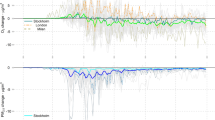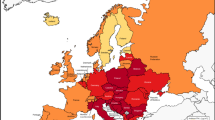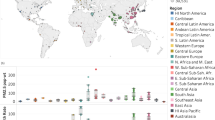Abstract
To date, only a limited number of studies have examined the impact of ambient pollutant policy on respiratory morbidities. This accountability study examined the effect of a regional pollution control policy, namely, the US Environmental Protection Agency's (EPA) nitrogen oxides (NOx) Budget Trading Program (NBP), on respiratory health in New York State (NYS). Time-series analysis using generalized additive models was applied to assess changes in daily hospitalizations for respiratory diseases in NYS after the implementation of the NBP policy. Respiratory end points in the summers during the baseline period (1997–2000) were compared with those during the post-intervention period (2004–2006). Stratified analyses were also conducted to examine whether health impacts of the NBP differed by socio-demographic, regional, or clinical characteristics. Following the implementation of EPA's NBP policy, there were significant reductions in mean ozone levels (−2% to −9%) throughout NYS. After adjusting for time-varying variables, PM2.5 concentration, and meteorological factors, significant post-intervention declines in respiratory admissions were observed in the Central (−10.18, 95% confidence interval (CI): −14.18, −6.01), Lower Hudson (−11.05, 95% CI: −16.54, −5.19), and New York City Metro regions (−5.71, 95% CI: −7.39, −4.00), consistent with wind trajectory patterns. Stratified analyses suggest that admissions for asthma, chronic airway obstruction, among those 5–17 years old, self-payers, Medicaid-covered, and rural residents declined the most post-NBP. This study suggests that the NOx control policy may have had a positive impact on both air pollution levels statewide and respiratory health in some NYS regions. However, the effect varied by disease subgroups, region, and socio-demographic characteristics.
This is a preview of subscription content, access via your institution
Access options
Subscribe to this journal
Receive 6 print issues and online access
$259.00 per year
only $43.17 per issue
Buy this article
- Purchase on Springer Link
- Instant access to full article PDF
Prices may be subject to local taxes which are calculated during checkout


Similar content being viewed by others
References
Rao S.T., Hogrefe C., Holloway T., and Kallos G. Long-range transport of atmospheric pollutants and transboundary pollution. In: Sokhi R.S. (ed.). World Atlas of Air Pollution, 1st edn. Anthem Press, New York, 2008, pp. 35–46.
US Environmental Protection Agency. Nitrogen Dioxide. Available at: http://www.epa.gov/air/nitrogenoxides/. (Accessed on 18 May 2011) 2011.
Bell M.L., Dominici F., and Samet J.M. A meta-analysis of time-series studies of ozone and mortality with comparison to the national morbidity, mortality, and air pollution study. Epidemiology 2005: 16: 436–445.
US Environmental Protection Agency. NOx Budget Trading Program/NBP 2003–2008. Basic Information. Available at: http://www.epa.gov/airmarkt/progsregs/nox/docs/NBPbasicinfo.pdf. (Accessed on 18 May 2011) 2009.
Godowich J.M., Pouliot G., and Rao S.T. Assessing multi-year changes in modeled and observed NOX concentrations from a dynamic evaluation perspective. Atmos Environ 2010: 44 (24): 2894–2901.
Ozone Transport Assessment Group (OTAG). Air Quality Analysis Workgroup's Volume 1: Executive SummaryRep. In: Guinnup, D., Collom, B. (eds.). Available at: http://capita.wustl.edu/otag/Reports/ExecSumm/AQASUM3.html. (Accessed on 24 May 2011) 1997.
Burnett R.T., Cakmak S., Brook J.R., and Krewski D. The role of particulate size and chemistry in the association between summertime ambient air pollution and hospitalization for cardiorespiratory diseases. Environ Health Perspect 1997: 105 (6): 614–620.
Lin S., Bell E.M., Liu W., Walker R.J., Kim N.K., and Hwang S.A. Ambient ozone concentration and hospital admissions due to childhood respiratory diseases in New York State, 1991–2001. Environ Res 2008: 108 (1): 42–47.
Peel J.L., Metzger K.B., Klein M., et al. Ambient air pollution and cardiovascular emergency department visits in potentially sensitive groups. Am J Epidemiol 2007: 165 (6): 625–633.
Zanobetti A., and Schwartz J. Air pollution and emergency admissions in Boston, MA. J Epidemiol Community Health 2006: 60 (10): 890–895.
Lobdell D.T., Isakov V., Baxter L., Touma J.S., Smuts M.B., and Özkaynak H. Feasibility of assessing public health impacts of air pollution reduction programs on a local scale: New Haven case study. Environ Health Perspect 2011: 119 (4): 487–493.
New York State Department of Environmental Conservation. Available at: http://www.dec.ny.gov/chemical/34985.html. (Accessed on 3 March 2011) 2010.
Garcia V.C., Foley K.L., Gego E., Holland D.M., and Rao S.T. A comparison of statistical techniques for combining modeled and observed concentrations to create high-resolution ozone air quality surfaces. J Air Waste Manage Assoc 2010: 60 (5): 586–595.
Hogrefe C., Lynn B., Goldberg R., Rosenzweig C., Zalewsky E., Hao W., et al. A combined model-observation approach to estimate historic gridded fields of PM2.5 mass and species concentrations. Atmos Environ 2009: 43 (16): 2561–2570.
Steadman R.G. A universal scale of apparent temperature. J Applied Meterol 1984: 23 (12): 1674–1687.
Naiman A., Glazier R.H., and Moineddin R. Association of anti-smoking legislation with rates of hospital admission for cardiovascular and respiratory conditions. Can Med Assoc J 2010: 182 (8): 761–767.
Peel J.L., Klein M., Flanders W.D., Mulholland J.A., and Tolbert P.E. Impact of improved air quality during the 1996 summer Olympic games in Atlanta on multiple cardiovascular and respiratory outcomes. Res Rep Health Eff Inst 2010: (148): 3–23.
Bailey D.T. Summer 1997 in Perspective. Environmental Protection Agency, Office of Air Quality and Policy Standards. Available at: http://www.epa.gov/oar/oaqps/pams/docs.html. (Accessed on 22 July 2011) 2009.
Godowitch J.M., Gilliland A.B., Draxler R.R., and Rao S.T. Modeling assessment of point source NOx emission reductions on ozone air quality in the eastern United States. Atmos Environ 2008: 42 (1): 87–100.
US Environmental Protection Agency. “Our nation's air status and trends through 2008” Office of Air Quality Planning and Standards, EPE-454/R-09-002. Available at: http://www.epa.gov/airtrends/2010/index.html. (Accessed on 5 March 2011) 2010.
Garcia V.C., Gego E., Lin S., Pantea C., Rappazzo K., Wootten A., et al. An evaluation of transported pollution and respiratory-related hospital admissions in the state of New York. Atmos Pollut Res 2011: 2 (1): 9–15.
Friedman M.S., Powell K.E., Hutwagner L., Graham L.M., and Teague W.G. Impact of changes in transportation and commuting behaviors during the 1996 Summer Olympic Games in Atlanta on air quality and childhood asthma. JAMA 2001: 285 (7): 897–905.
Hubbell B.J., Hallberg A., McCubbin D.R., and Post E. Health-related benefits of attaining the 8-hr ozone standard. Environ Health Perspect 2005: 113 (1): 73–82.
West J.J., Naik V., Horowitz L.W., and Fiore A.M. Effect of regional precursor emission controls on long-range ozone transport—Part 2: steady-state changes in ozone air quality and impacts on human mortality. Atmos Chem Phys Discuss 2009: 9: 7079–7113.
Chay K.Y., and Greenstone M. Air Quality, Infant Mortality, and the Clean Air Act of 1970. National Bureau of Economic Research Working Paper No. 10053, October 2003.
Li Y., Wang W., Kan H., et al. Air Quality and outpatient visits for asthma in adults during the 2009 Summer Olympic Games in Beijing. Sci Total Environ 2010: 408: 1226–1227.
US Census Bureau. Hispanics in the United States. Available at: http://www.census.gov/population/www/socdemo/hispanic/files/Internet_Hispanic_in_US_2006.pdf (accessed on 24 May 2011).
Lin S., Munsie J.P., Hwang S., Fitzgerald E., and Cayo M.R. Childhood asthma hospitalization and residential exposure to state route traffic. Environ Res 2002: A (88): 73–81.
Sacks J.D., Stanek L.W., Luben T.J., Johns D.O., Buckley B.J., Brown J.S., and Ross M. Particulate matter induced health effects: who's susceptible? Environ Health Perspect 2011; 119 (4): 446–454.
Gego E., Gilliand A., Godowitch J., and Rao S.T. Modeling analyses of the effects of changes in nitrogen oxides emissions from the electric power sector on ozone levels in the eastern United States. J Air Waste Manage Assoc 2008: 58: 580–588.
US Environmental Protection Agency. Analysis of NOX Budget Trading Program Units Brought into the CAIR NOX Ozone Season Trading Program. Technical Support Document for the Transport Rule, Docket ID No. EPA-HQ-OAR-2009-0491 2009.
Bernstein A.B., Hing E., Moss A.J., Allen K.F., Siller A.B., and Tiggle R.B. Health Care in America: Trends in Utilization. National Center for Health Statistics, Hyattsville, Maryland, 2003.
Jones A.P. Asthma and the home environment. J Asthma 2000: 37 (2): 103–124.
Bergin M.S., Shih J.-S., Krupnick A.J.,, Boylan J.W., Wilkinson J.G., Odman M.T., et al. Regional Air Quality: Local and Interstate Impacts of NOx and SO2 Emissions Ozone and Fine Particulate Emissions in the Eastern United States. Environ Sci Technol 2007: 41: 4677–4689.
Lin S., Luo M., Walker R.J., Liu X., Hwang S.A., and Chinery R. Extreme high temperatures and hospital admissions for respiratory and cardiovascular diseases. Epidemiology 2009: 20 (5): 738–746.
Juster H.R., Loomis B.R., Hinman T.M., Farrelly M.C., Hyland A., Bauer U.E., et al. Declines in hospital admissions for acute myocardial infarction in New York state after implementation of a comprehensive smoking ban. Am J Public Health 2007: 97 (11): 2035–2039.
Shetty K.D., DeLeire T., White C., and Bhattacharya J. Changes in U.S. hospitalizations and mortality rates following smoking bans. National Bureau of Economic Research Working paper No. 14790, March 2009.
Gego E., Porter P.S., Gilliland A., and Rao S.T. Observation-based assessment of the impact of nitrogen oxides emissions reductions on ozone air quality over the eastern United States. J Appl Meteorol Climatol 2007: 46 (7): 994–1008.
Author information
Authors and Affiliations
Corresponding author
Ethics declarations
Competing interests
The authors declare no conflict of interest.
Additional information
Disclaimer
The United States Environmental Protection Agency through its Office of Research and Development collaborated in the research described hereunder. It has been subjected to Agency review and approved for publication.
Rights and permissions
About this article
Cite this article
Lin, S., Jones, R., Pantea, C. et al. Impact of NOx emissions reduction policy on hospitalizations for respiratory disease in New York State. J Expo Sci Environ Epidemiol 23, 73–80 (2013). https://doi.org/10.1038/jes.2012.69
Received:
Accepted:
Published:
Issue Date:
DOI: https://doi.org/10.1038/jes.2012.69



